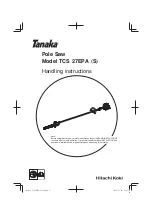
F 000 622 216 | 10.2011
Bosch Power Tools
English |
19
of blade pinching and kickback. Large
panels tend to sag under their own weight.
Supports must be placed under the panel on
both sides, near the line of cut and near the
edge of the panel.
• Do not use dull or damaged saw blades.
Unsharpened or improperly set blades
produce narrow kerf causing excessive
friction, blade binding and kickback.
• Before sawing, tighten the blade depth
andcutting angle adjustments. If the
adjustments change during cutting, the saw
blade can jam and kickback can occur.
• Use extra caution when making “plunge
cuts” into existing walls or other blind areas.
The protruding saw blade, when running into
hidden objects, can be jammed and cause
kickback.
• Check the lower guard for proper closing
before each use. Do not operate the saw
if the lower guard does not move freely
and close instantly. Never clamp or tie the
lower guard into the open position. If saw
is accidentally dropped, the lower guard
may be bent. Raise the lower guard with the
retracting handle and make sure it moves
freely and does not touch the blade or any
other part, in all angles and depths of cut.
• Check the operation of the lower guard
spring. If the guard and the spring are not
operating properly, they must be serviced
before use. The lower guard may operate
sluggishly due to damaged parts, gummy
depositsor a build-up of debris.
• The lower guard should be retracted
manually only for special cuts such as
“plunge cuts” and “compound cuts”. Raise
the lower guard with the retracting handle
and as soon as blade enters the material,
the lower guard must be released. For all
other sawing, the lower guard must operate
automatically.
• Always observe that the lower guard is
covering the saw blade before placing down
the saw on a workbench or the floor. An
unprotected, coasting blade will cause the
saw to travel backwards, cutting whatever is
in its path. Be aware of the run-on period of
the saw.
• Do not reach into the saw dust ejector with
your hands. They could be injured by rotating
parts.
• Do not work overhead with the saw. In this
manner you do not have sufficient control
over the power tool.
• Use suitable detectors to determine if utility
lines are hidden in the work area or call the
local utility company for assistance. Contact
with electric lines can lead to fire and
electric shock. Damaging a gas line can lead
to explosion. Penetrating a water line causes
property damage or may cause an electric
shock.
• Do not operate the power tool stationary.
It is not designed for operation with a saw
table.
• Do not use high speed steel (HSS) saw
blades. Such saw blades can easily break.
Starting Operation
Observe correct mains voltage: The voltage of
the power source must agree with the voltage
specified on the nameplate of the machine.
Equipment marked with 230V can also be
connected to 220V.
Switching On and Off
For starting operation of the machine, actuate
the lock-off button 2 first, and then press and
hold the On/Off switch 1 afterwards.
To switch off the machine, release the On/Off
switch 1.
For safety reasons the On/Off switch of
the machine cannot be locked; it must
remain pressed during the entire
operation.
Adjusting the Cutting Depth (see figure B )
• Before any work on the machine itself, pull
the mains plug.
To achieve an optimum cut, the saw blade
must not protrude the material by more than 3
mm orone tooth (maximum). See figure C .
To adjust the cutting depth, loosen winged
screw 21 and raise the saw from the base plate
11 or lower it towards the base plate,
respectively:
Raise
g
for smaller cutting depths
Lower
g
for greater cutting depths
Retighten the winged screw 21.
Adjusting the Cutting Angle
• Before any work on the machine itself, pull
the mains plug.
Loosen the winged screws 6.
It is best to place the machine on the face side
of the blade guard. Tilt the base plate away from
the machine until the required cutting angle is
adjusted on the cutting angle scale 4. Tighten
the winged screws again.
GKS 7 1/4 Professional.indd 19
29/11/11 08:55
Содержание GKS 7 1/4 Professional
Страница 1: ...F 000 622 216 10 2011 Bosch Power Tools 1 2 F 000 622 216 10 2011 Bosch Power Tools ...
Страница 2: ...F 000 622 216 10 2011 Bosch Power Tools 2 GKS 7 1 4 Professional indd 2 29 11 11 08 54 ...
Страница 3: ... 3 F 000 622 216 10 2011 Bosch Power Tools GKS 7 1 4 Professional indd 3 29 11 11 08 55 ...





































